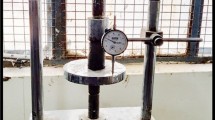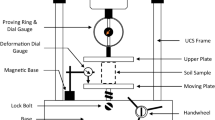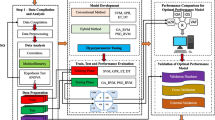Abstract
The present research determines the effect of training data sets, correlation, and multicollinearity on the performance and overfitting of gene expression programming (GEP) and relevance vector machine (RVM) models in predicting the soaked CBR of fine-grained soil. For this purpose, one hundred and 82 training data sets have been compiled and subdivided into 50%, 60%, 70%, 80%, 90%, and 100%. In addition, 15 testing, 36 validation, and 12 laboratory-tested data sets have been compiled for trained models. The linear, polynomial, gaussian, and Laplacian kernels have been used to develop each GA and PSO optimized relevance vector machine (RVM) model, which have been trained by 50–100% training data sets. Thus, SRVM (single kernel-based) and HRVM (dual kernel-based) models have been developed and trained. The performance of models has been measured by RMSE, MAE, and R performance indicators. Based on the performance comparison, Model 21 (R = 0.9874) & Model 39 (R = 0.9748) of SRVM, and Model 51 (R = 0.9606) and Model 57 (R = 0.9701) of HRVM have been identified as better performing RVM models. However, GEP model 62 has performed (R = 0.8847) less than RVM models. The test performance comparison shows that model 21 has outperformed models 39, 51, 57, and 62 in predicting the soaked CBR of fine-grained soil. In addition, model 21 (performance = 0.8631) has predicted soaked CBR for the validation data set better than published models. Finally, the present research concludes that model 21 (GA optimized Laplacian kernel-based SRVM model) is a robust model that can predict the soaked CBR of fine-grained soil with the least prediction error and high performance.


















Similar content being viewed by others
Data availability
All data, models, and code generated or used during the study appear in the submitted article. The laboratory-test database can be provided on the request.
Abbreviations
- AI:
-
Artificial intelligence
- ANN:
-
Artificial neural networks
- C:
-
Clay content
- CBR:
-
California bearing ratio
- CC :
-
Coefficient of curvature
- CL:
-
Confidence level
- CL:
-
Inorganic clays of low plasticity
- CS:
-
Coarse sand
- C U :
-
Coefficient of uniformity
- D 10 :
-
Particle size at 10% fine
- D 30 :
-
Particle size at 30% fine
- D 50 :
-
Particle size at 50% fine
- D 60 :
-
Particle size at 60% fine
- DCP:
-
Dynamic cone penetration
- DUW:
-
Dry unit weight of soil
- FC:
-
Fine content
- FD:
-
Frequency distribution
- FS:
-
Fine sand
- FSI:
-
Free swell index
- G:
-
Gravel content
- GA:
-
Genetic algorithm
- GEP:
-
Gene expression programming
- GMDH-NN:
-
Group method of data handling neural network
- HRVM:
-
Hybrid/two kernel-based relevance vector machine
- IS:
-
Indian Standards
- LL:
-
Liquid limit
- M:
-
Silt content
- MAE:
-
Mean absolute error
- MDD:
-
Maximum dry density
- MLR:
-
Multiple linear regression
- NUW:
-
Natural unit weight of soil
- OC:
-
Organic content
- OMC:
-
Optimum moisture content
- OWC:
-
Optimum water content
- PI:
-
Plasticity index
- PL:
-
Plastic limit
- PSO:
-
Particle swarm optimization
- R :
-
Correlation coefficient
- R 2 :
-
Coefficient of determination
- RMSE:
-
Root mean square error
- RVM:
-
Relevance vector machine
- S :
-
Sand content
- SPSS:
-
Statistical package for the social sciences
- SPT-N:
-
Standard penetration test number
- SRVM:
-
Single kernel-based relevance vector machine
- St. Dev:
-
Standard deviation
References
Abdelkader HA, Hussein M, Ye H (2021) Influence of waste marble dust on the improvement of expansive clay soils. Adv Civil Eng. https://doi.org/10.1155/2021/3192122
Ajalloeian R, Mojtaba K (2015) Predicting maximum dry density, optimum moisture content and California bearing ratio (CBR) through soil index using ordinary least squares (OLS) and artificial neural networks (ANNS). Int J Innov Technol Explor Eng 3(3):1–5
Akanbi DO (2021) Performance evaluation of crushed glass in stabilizing lateritic soil for road pavement layers. Saudi J Eng Technol 6(4):77–83. https://doi.org/10.36348/sjet.2021.v06i04.006
Alam SK, Mondal A, Shiuly A (2020) Prediction of CBR value of fine grained soils of Bengal Basin by genetic expression programming, artificial neural network and krigging method. J Geol Soc India 95(2):190–196. https://doi.org/10.1007/s12594-020-1409-0
Alhassan M (2008) Potentials of rice husk ash for soil stabilization. AU J Technol 11(4):246–250
Al-Refeai T, Al-Suhaibani A (1997) Prediction of CBR using dynamic cone penetrometer. J King Saud Univ Eng Sci 9(2):191–203. https://doi.org/10.1016/S1018-3639(18)30676-7
Al-Soudany K (2018) Remediation of clayey soil using silica fume. In: MATEC Web of Conferences (Vol. 162, p. 01017). EDP Sciences. https://doi.org/10.1051/matecconf/201816201017.
Amena S (2021) Experimental study on the effect of plastic waste strips and waste brick powder on strength parameters of expansive soils. Heliyon 7(11):e08278. https://doi.org/10.1016/j.heliyon.2021.e08278
Araujo W, Ruiz G (2016) Correlation equations of CBR with index properties of soil in the city of Piura. In: Proceeding of 14th LACCEI International Multi-conference for Engineering, Education and Technology (pp. 1–7).
Ardakani A, Kordnaeij A (2019) Soil compaction parameters prediction using GMDH-type neural network and genetic algorithm. Eur J Environ Civ Eng 23(4):449–462. https://doi.org/10.1080/19648189.2017.1304269
Azim MAM, Azhar ATS, Tarmizi AKA, Shahidan S, Nabila ATA (2017) Enhancing the compressive strength of landfill soil using cement and bagasse ash. In: IOP Conference Series: Materials Science and Engineering (Vol. 271, No. 1, p. 012053). IOP Publishing, https://doi.org/10.1088/1757-899X/271/1/012053.
Bandyopadhyay TS, Singh AA, Pandey V, Singh JP (2016) Stabilization of soil using GGBS and calcium carbide residue. Int J Innov Res Sci Eng Technol 5(9):17023–17030
Blayi RA, Sherwani AFH, Ibrahim HH, Abdullah SJ (2020a) Stabilization of high-plasticity silt using waste brick powder. SN Appl Sci 2(12):1–12. https://doi.org/10.1007/s42452-020-03814-8
Blayi RA, Sherwani AFH, Ibrahim HH, Faraj RH, Daraei A (2020b) Strength improvement of expansive soil by utilizing waste glass powder. Case Stud Construct Mater 13:e00427. https://doi.org/10.1016/j.cscm.2020.e00427
Bourouis MA, Zadjaoui A, Djedid A (2016) Neuro-genetic approach for immersed CBR index prediction. In: Proceedings of the First Southern African Geotechnical Conference, Sun City (pp. 143–148). https://doi.org/10.3217/978-3-85125-564-5-046.
Chandrakar V, Yadav RK (2016) Study of correlation of CBR value with engineering properties and index properties of coarse grained soil. Internat Res J Eng Tech (IRJET) 3: 772–778.
Dabou B, Kanali C (2021) Structural performance of laterite soil stabilised with cement and blue gum (Eucalyptus Globulus) wood ash for use as a road base material. arXiv preprint https://arxiv.org/abs/2109.08507, https://doi.org/10.14445/22315381/IJETT-V69I9P231.
Datta T, Chottopadhyay BC (2011) Correlation between CBR and index properties of soil. In: Proceedings of Indian Geotechnical Conference, Kochi (pp. 131–133).
Edil TB, Acosta HA, Benson CH (2006) Stabilizing soft fine-grained soils with fly ash. J Mater Civ Eng 18(2):283–294. https://doi.org/10.1061/ASCE0899-1561200618:2(283)
Eltwati AS, Tarhuni F, Elkaseh A (2020) Engineering properties of clayey soil stabilized with waste granite dust. J Criti Rev 7(16):794–802
González Farias I, Araujo W, Ruiz G (2018) Prediction of California bearing ratio from index properties of soils using parametric and non-parametric models. Geotech Geol Eng 36(6):3485–3498. https://doi.org/10.1007/s10706-018-0548-1
Gül Y, Çayir HM (2021) Prediction of the California bearing ratio from some field measurements of soils. In: Proceedings of the Institution of Civil Engineers-Municipal Engineer (Vol. 174, No. 4, pp. 241–250). Thomas Telford Ltd, https://doi.org/10.1680/jmuen.19.00020.
Hair JF, Ortinau DJ, Harrison DE (2010) Essentials of marketing research (vol. 2). McGraw-Hill/Irwin, New York
Harini H, Naagesh S (2014) Predicting CBR of fine grained soils by artificial neural network and multiple linear regression. Int J Civil Eng 5(2):119–126
Indian Standard: 2720: (P-16) 1979, Method of test for soil: Laboratory determination of CBR.
Janjua ZS, Chand J (2016) Correlation of CBR with index properties of soil. Int J Civil Eng Technol 7(5):57–62
Ji-ru Z, Xing C (2002) Stabilization of expansive soil by lime and fly ash. J Wuhan Univ Technol Mater Sci Ed 17(4): 73–77. https://doi.org/10.1007/BF02838423.
Kadhim YM, Al-Adhamii RA, Fattah MY (2022) Geotechnical properties of clayey soil improved by sewage sludge ash. J Air Waste Manag Assoc 72(1):34–47. https://doi.org/10.1080/10962247.2020.1862939
Keshav K, Mishra MK, Singh JP (2018) Stabilization of soil using sodium hydroxide additive. Int J Res Eng Appl Manag 4(2):328–332. https://doi.org/10.18231/2454-9150.2018.0166
Kulkarni PP, Mandal JN (2017) Performance assessment of stabilized soil with fly ash-nano material mixes. J Geotech Transp Eng 3(2):35–46
Kumar S, Chouksey A, Priyanka (2017) Stabilization of sub-grade using fly ash and geosynthetic material. Int J Adv Technol Eng Sci 5(06).
Kurnaz TF, Kaya Y (2019) Prediction of the California bearing ratio (CBR) of compacted soils by using GMDH-type neural network. Eur Phys J plus 134(7):326. https://doi.org/10.1140/epjp/i2019-12692-0
Mahdi Z, Alhassnawi N (2018) Assessment of subgrade soil improvement by waste glass powder. Int J Civil Eng Technol 9:12–21
Mittal A (2021) Effect of rice husk ash and stone dust on selecting engineering properties of poor subgrade soil. Jordan J Civil Eng 15(1):133–141
Murmu AL, Dhole N, Patel A (2020) Stabilisation of black cotton soil for subgrade application using fly ash geopolymer. Road Mater Pavem Design 21(3):867–885. https://doi.org/10.1080/14680629.2018.1530131
Negi C, Yadav RK, Singhai AK (2013) Effect of silica fume on engineering properties of black cotton soil. Int J Comput Eng Res(IJCER): 83.
Patel RS, Desai MD (2010) CBR predicted by index properties for alluvial soils of South Gujarat. In: Proceedings of the Indian geotechnical conference, Mumbai (pp. 79–82).
Phani Kumar V, Manjula Ch, Poornima P (2015) Artificial neural networks (ANNS) for predicting of California bearing ratio of soils. Int J Mod Eng Res 5(1):15–21
Pradeep Kumar KJ, Harish Patel YM (2016) Soft computing technique for prediction of CBR form index properties of subgrade soil. Int J Innov Res Sci Eng Technol 5(7):13852–13860. https://doi.org/10.15680/IJIRSET.2016.0507214
Ramasubbarao G, Sankar SG (2013) Predicting soaked CBR value of fine grained soils using index and compaction characteristics. Jordan J Civil Eng 7(3):354–360
Ravichandra AH, Shivakumar K, Vinaykumar H, Md. Khalid S, Basavaraj B (2019) Prediction of CBR value by using index properties of soil. Int Res J Eng Technol 6(7):3740–3747
Reddy S, Ruchita N, Sharma P, Satyanarayana SV (2019) Prediction of California bearing ratio through empirical correlations of index properties for tropical indian soils. Int J Innov Eng Technol 15(1): 67–77. https://doi.org/10.21172/ijiet.151.09.
Rehman AU, Farooq K, Mujtaba H (2017a) Prediction of California bearing ratio (CBR) and compaction characteristics of granular soils. Acta Geotechnica Slovenica 14(1):63–72
Rehman ZU, Khalid U, Farooq K, Mujtaba H (2017b) Prediction of CBR value from index properties of different soils. Technol J Univ Eng Technol (UET) 22:17–26
Rohith MS, Kumar DRS, Paul W, KumaraSwamy N (2018) A study on the effect of stabilizers (zycobond and terrasil) on strength of subgrade on BC soil. Indian J Sci Res 17(2):86–92
Senol A, Bin-Shafique MS, Edil TB, Benson CH (2002) Use of class C fly ash for stabilization of soft subgrade. In: Fifth International Congress on Advances in Civil Engineering (pp. 25–27). Istanbul, Turkey: Istanbul Technical University.
Shirur NB, Hiremath SG (2014) Establishing relationship between CBR value and physical properties of soil. IOSR J Mech Civil Eng 11(5):26–30
Shivaramaiah A, Ravi Shankar AU, Singh A, Pammar KH (2020) Utilization of lateritic soil stabilized with alkali solution and ground granulated blast furnace slag as a base course in flexible pavement construction. Int J Pavem Res Technol 13(5):478–488. https://doi.org/10.1007/s42947-020-0251-5
Smith GN (1986) Probability and statistics in civil engineering. Collins professional and technical books, pp 244.
Talukdar DK (2014) A study of correlation between California bearing ratio (CBR) value with other properties of soil. Int J Emerg Technol Adv Eng 4(1):559–562
Taskiran T (2010) Prediction of California bearing ratio (CBR) of fine grained soils by AI methods. Adv Eng Softw 41(6):886–892. https://doi.org/10.1016/j.advengsoft.2010.01.003
Teklehaymanot FG, Alene E (2021) CBR predictive model development from soil index and compaction properties in case of fine-grained soils of Debre-Tabor City, Ethiopia. Int J Adv Sci Eng 8(2):2224–2234
Tenpe AR, Patel A (2020) Utilization of support vector models and gene expression programming for soil strength modeling. Arab J Sci Eng 45(5):4301–4319. https://doi.org/10.1007/s13369-020-04441-6
Tipping ME (2001) Sparse Bayesian learning and the relevance vector machine. J Mach Learn Res 1(Jun):211–244.
Vandana Rao P, Sudheer Kumar G, Prasanthi B (2018) A parametric study on black cotton soil stabilized using rice husk ash. Int J Adv Manag Technol Eng Sci 8(4):623–632
Venkatasubramanian C, Dhinakaran G (2011) ANN model for predicting CBR from index properties of soils. Int J Civ Struct Eng 2(2):614–620
Vu DQ, Nguyen DD, Bui QAT, Trong DK, Prakash I, Pham BT (2021) Estimation of California bearing ratio of soils using random forest based machine learning. J Sci Transp Technol:48–61
Vukićević M, Maraš-Dragojević S, Jocković S, Marjanović M, Pujević V (2013) Research results of fine-grained soil stabilization using fly ash from Serbian electric power plants. In: 18th International Conference on Soil Mechanics and Geotechnical Engineering (pp. 2–6).
Vukićević M, Pujević V, Marjanović M, Jocković S, Maraš-Dragojević S (2015) Fine grained soil stabilization using class F fly ash with and without cement. In: Proceedings of the XVI ECSMGE Geotechnical Engineering for Infrastructure and Development, ISBN 978–0–7277–6067–8, pp. 2671–2676.
Wilches FJ, Burbano JLA, Sierra EEC (2020) Subgrade soils characterization data, for correlation of geotechnical variables on urban roads in northern Colombia. Data Brief 32:106095. https://doi.org/10.1016/j.dib.2020.106095
Yin Z, Lekalpure RL, Ndiema KM (2022) Experimental study of black cotton soil stabilization with natural lime and pozzolans in pavement subgrade construction. Coatings 12(1):103. https://doi.org/10.3390/coatings12010103
Zhong J, Feng L, Ong YS (2017) Gene expression programming: A survey. IEEE Comput Intell Mag 12(3):54–72. https://doi.org/10.1109/MCI.2017.2708618
Funding
No funding was received in assisting the preparation of this manuscript.
Author information
Authors and Affiliations
Contributions
JK: main author, conceptualization, literature review, manuscript preparation, application of AI models, methodological development, statistical analysis, detailing, and overall analysis; KSG: conceptualization, manuscript finalization, detailed review and editing.
Corresponding author
Ethics declarations
Conflict of interest
The authors declare that there is no conflict of interest.
Additional information
Publisher's Note
Springer Nature remains neutral with regard to jurisdictional claims in published maps and institutional affiliations.
Supplementary Information
Below is the link to the electronic supplementary material.
Rights and permissions
Springer Nature or its licensor holds exclusive rights to this article under a publishing agreement with the author(s) or other rightsholder(s); author self-archiving of the accepted manuscript version of this article is solely governed by the terms of such publishing agreement and applicable law.
About this article
Cite this article
Khatti, J., Grover, K.S. Prediction of soaked CBR of fine-grained soils using soft computing techniques. Multiscale and Multidiscip. Model. Exp. and Des. 6, 97–121 (2023). https://doi.org/10.1007/s41939-022-00131-y
Received:
Accepted:
Published:
Issue Date:
DOI: https://doi.org/10.1007/s41939-022-00131-y




